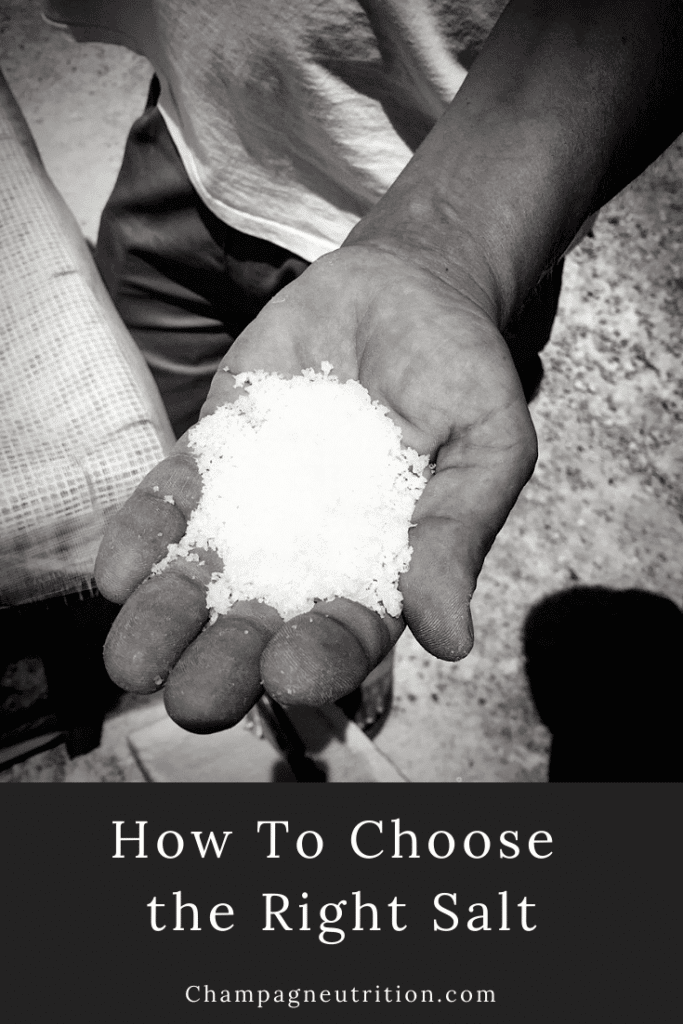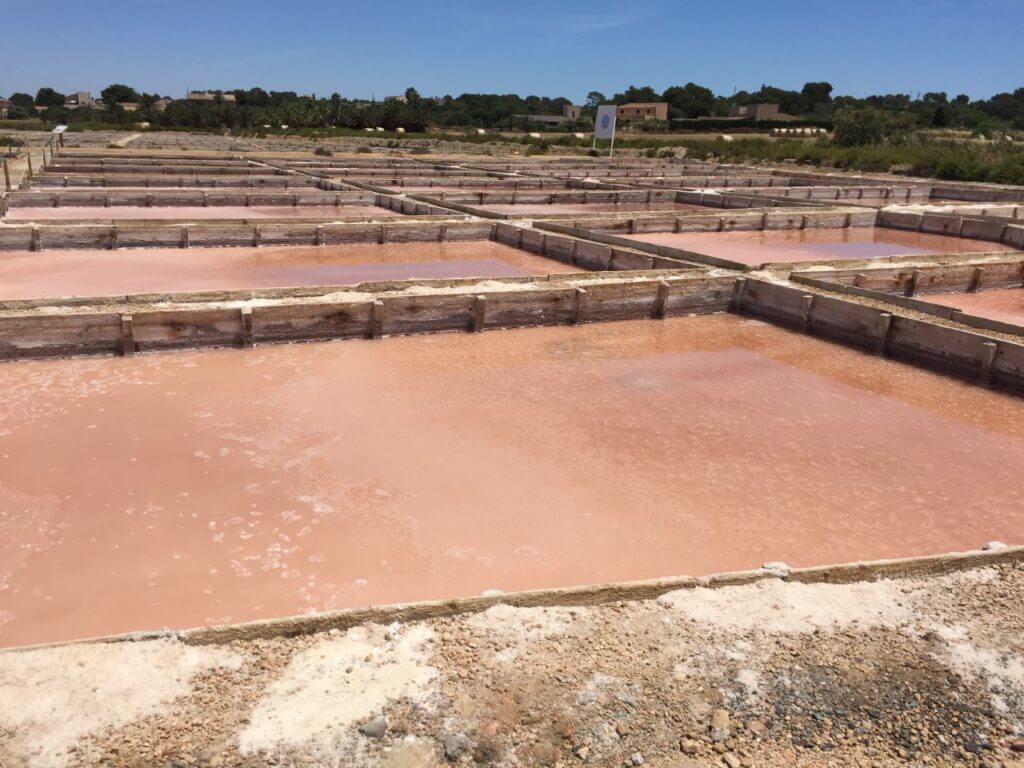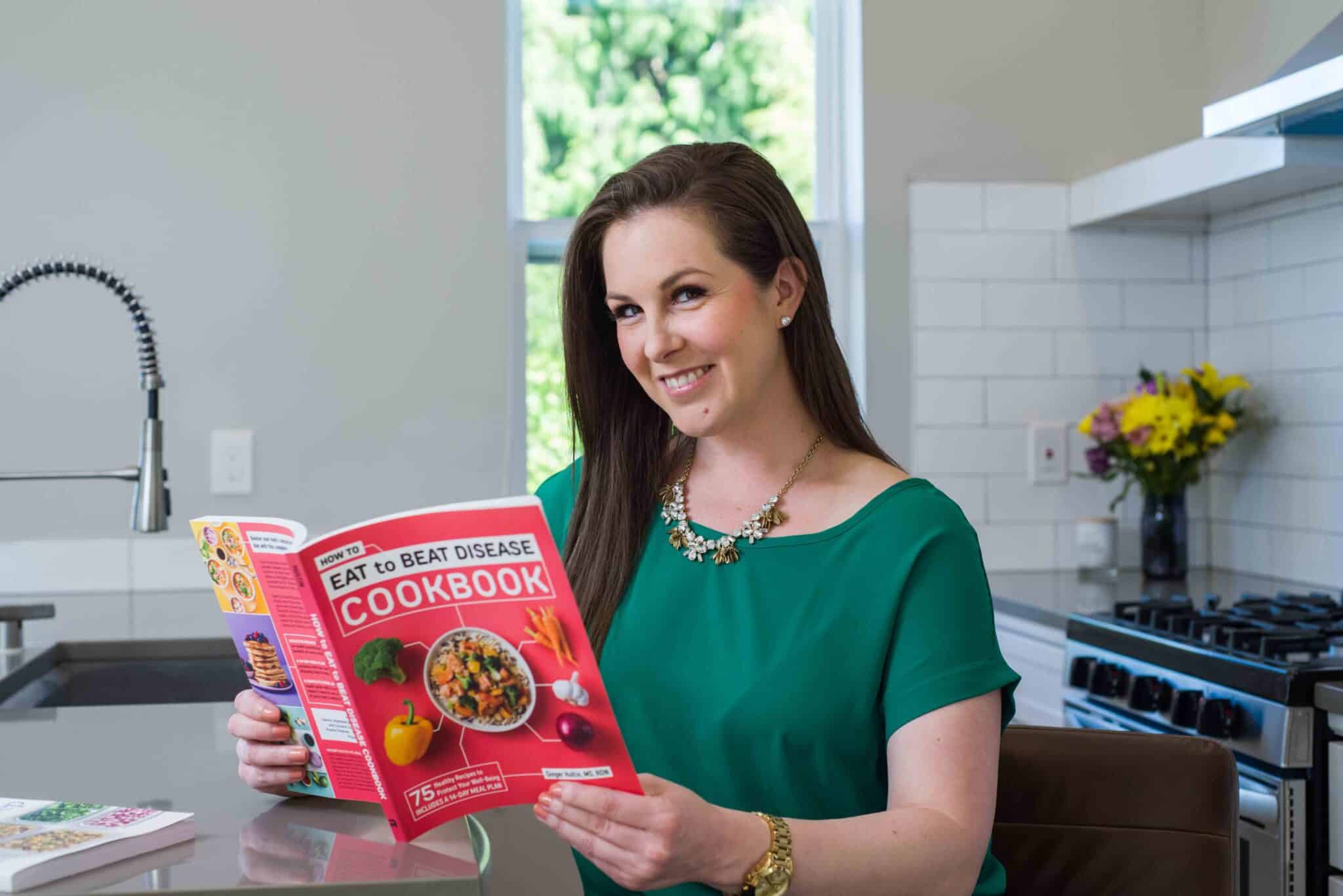How to Choose The Right Salt
June 1, 2017 by Ginger Hultin MS RDN
Have you ever wondered how to choose the right salt? As a dietitian, I get asked this question ALL the time. With the continued trend of flaky, colored sea salts and Himalayan salts it can be confusing to know which to choose. Known for being richer in minerals than regular table salt, sea salt and Himalayan salt are touted as enhancing the taste of food and being less processed than “regular” salt. Coming to us in colors like pink and black, they are undeniably beautiful but are they better?

I had the opportunity to learn a lot about sea salt when I visited Mallorca (also called Majorca), an island off the coast of Spain in the Mediterranean. I was able to go on a salt tour at Flor de Sal d’Es Trenc where they produce premium sea salt called Flor de Sal. I learned about how sea water is brought into man-made holding areas where it evaporates in the sun, leaving behind salt and other minerals. After seeing my tour guide scoop salt off the top of a salt pond with a rake and hold it in his hands, I could imagine myself spending more money for Flor de Sal in the future. I have a better understanding where it came from, how difficult it is to ‘make’ and it’s value.
Seeing the salt ponds in person was incredible and gave me an appreciation for Flor de Sal. There are many other types of salt available though, each with a different story and purpose. So how do you choose the right salt? I’d say it depends on how you want to use it!

Salt pools in Mallorca Spain waiting for sea water to evaporate and leave it’s salt and minerals behind
How to Choose The Right Salt
- Table Salt: Table salt, or regular salt, is the most widely used salt and what you typically find in salt shakers. It is mined from salt deposits and processed to remove impurities and minerals. As a result of the minerals being removed, table salt has the highest sodium content (by weight) of all the salts. The salt is ground into a fine texture and has anti-caking agents added to keep it from clumping together. The fine texture and consistent size allow for reliable measurements in teaspoon or tablespoon increments. It also allows for easy mixing and quick dissolving when used for cooking or baking. In general, when recipes say “salt” they are referring to table salt and other types of salt should not be substituted without adjusting for texture. Iodine is added to most table salt to prevent iodine deficiencies which are common in some parts of the world.
- Kosher Salt: Kosher salt has a coarse, flaky texture. It is a favorite of chefs due to its easy to pinch texture and how quickly it dissolves. It typically does not contain anti-caking agents or iodine. Kosher salt is generally less pungent than table salt, but has a similar sodium content by weight. Even though the sodium content is similar, kosher and table salt should not be used interchangeable in recipes without making adjustments. The texture differences make traditional (teaspoon or tablespoon) measurements unreliable and would result in meals that are either too salty or not salty enough. Kosher salt is great as a finishing salt sprinkled over food just before serving. It’s flaky texture also makes it ideal for salting the rim of cocktail glasses.
- Sea Salt: Sea salt is broad term and you may see many different types of sea salt. It is made from the evaporation of saltwater, which leaves the salt and minerals behind. Sea salt is minimally processed and contains trace amounts of minerals like calcium, zinc, iron, magnesium and potassium. The specific minerals and amounts depend on where the salt was harvested from. The mineral content in sea salt is too low to offer a health advantage and these minerals can be obtained by eating other healthy foods. Sea salt does have a stronger flavor (from the minerals) and more coarse texture than table salt. The sodium content is slightly lower than table salt by weight. As with kosher salt, sea salt and table salt should not be used interchangeable in recipes without adjusting for the difference in texture. Many recipes now call specifically for sea salt. It is also commonly used as a finishing salt to provide a burst of flavor.
- Himalayan Salt: Himalayan salts are mined from the Punjab province of Pakistan. They have a coarse texture similar to sea salt and contain small amounts of minerals like calcium, iron, potassium and magnesium. The mineral content results in a slightly lower sodium content than table salt and a bolder flavor. The pink color comes from the iron content and is the biggest difference between Himalayan and table salt. Himalayan salt can be used in cooking and as a finishing salt sprinkled over the top of foods just before serving. It is also a great option for salting the rim of cocktail glasses.
- Flor de Sal or Fleur de Sel: Fleur de sel (“flower of salt”) is a premium salt. A form of sea salt, it is harvested (manually with wooden rakes) just as the salt begins to crystallize on top of saltwater pods as the water evaporates. This is the least processed salt. It is not crushed, ground or stripped of any minerals. It has a lower sodium content than other types of salt due to the higher mineral content. The salt has a thin and delicate texture and a blue-grey color. Fleur de sel is the most expensive salt ($14.99 for 6.3 oz) because of the labor intensive harvesting. It is used as a finishing salt for all your favorite meals, including sweets.
After seeing how they collect salt naturally, I have a new appreciation for the process. The sodium content of all types of salt are so close that it really is not a factor in determining which salt to choose. If you just need some salt for a recipe, perhaps use table salt. If you prefer a more natural product, a beautiful natural color, or the flavor of added minerals, sea salt or Himalayan salt might be the right choice for you. If you are looking for a burst of flavor on top of your favorite dish, Flor de Sal might be the right choice. I’m not sure if I can say one is “better” than the other (how ‘dietitian’ of me), but rather that it depends on your preference and the use.
Here are just a couple of my favorite recipes that use different types of salt: A Healthier Margarita, Salt&Pepper Pumpkin Seeds, Salty Sweet Peanut Butter and Jelly Homemade Granola.
So what do you think? How do you choose the right salt?

Ginger Hultin,MS, RD, CSO
Thanks for visiting! If you're struggling with a cancer diagnosis, autoimmune condition, gut health problems, or even a medical mystery, nutrition can make a HUGE difference in your day-to-day life. I run a virtual, concierge private practice where I partner with my clients over time to help them improve their health through nutrition. Be sure to visit the blog for easy, plant-based, anti-inflammatory recipes and our "Resources" page for a variety of self-paced programs, books, e-books, and nutrition podcast episodes.

